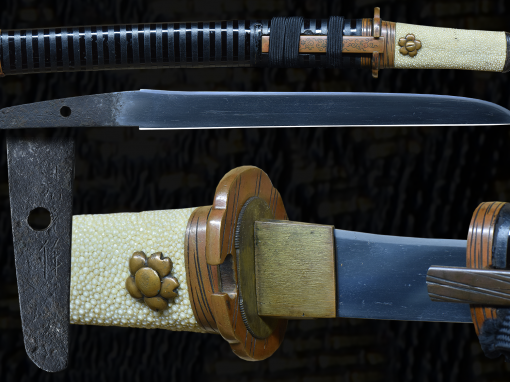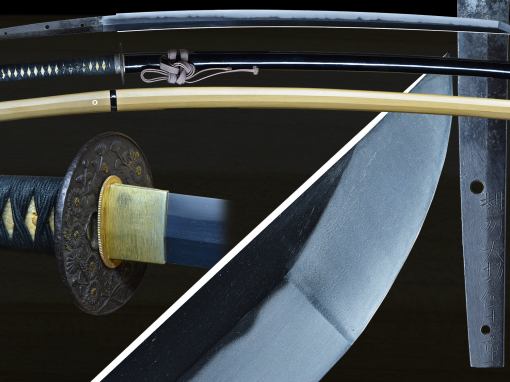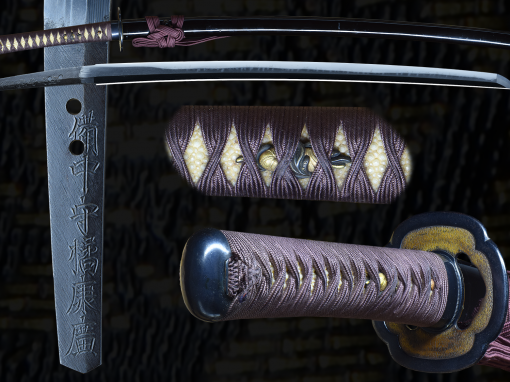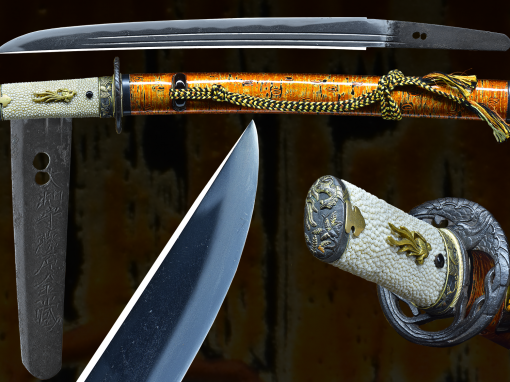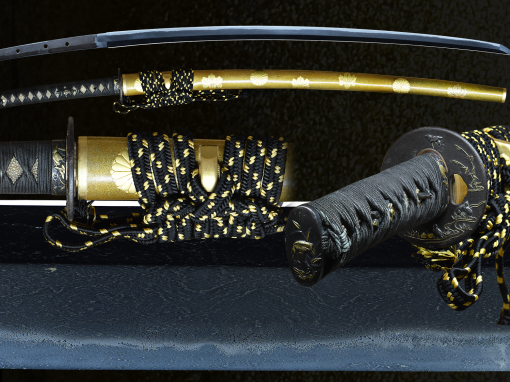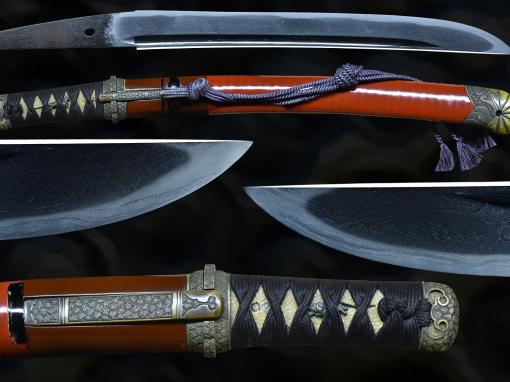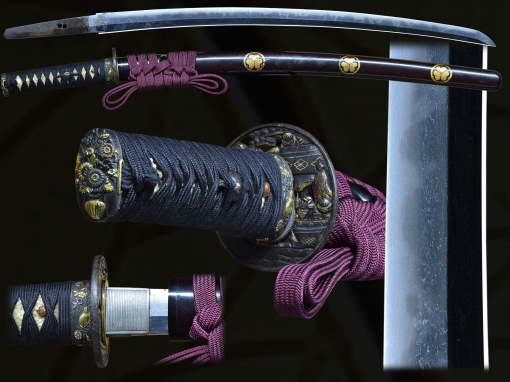We have a fine example of a Hamabe blade signed by Toshitaka with sayagaki. This sword is an exquisite example of the Hamabe school blade. A brilliant Choji/Gunome midare
Hamabe of Inaba
Kawamura Toshitaka.
Student of Toshizane, some references say Toshinori, born in Inaba his name was Kawamura Saburô he later became the Ueda Han smith. It was in that capacity that he had his greatest claim to fame as the first teacher of Yamaura Saneo and his brother Minamoto Kiyomaro. He lived and worked in Mino circa Bunsei (文政), dated works may be seen from (文化) Bunka 10 and (文政) Bunsei 6, 9 and 13. Signatures include; 寿隆Toshitaka, 河村三郎寿隆Kawamura Saburô Toshitaka, 眠龍子寿隆Minryushi Toshitaka, and 信上田士相州産源寿隆造
Shin Ueda-shi Sôshû san Minamoto Toshitaka tsukuru. Note; This is not the same smith as Sagami (no) Kuni Yagi Minamoto Toshitaka
The Hamabe Toshinori Group
The Hamabe group served the Tottori family of Inaba Han located on the Japan seaside of Honshu on the Sanindô highroad.
Hamabe Toshinori – his given name was Hamabe Kyurôemon, his first name as a working smith was Kaneyoshi 兼賀, he was then under the tutelage of Kanesaki, later in Edo he used the mei Toshinori 頴悳. It is said given the remoteness of his home in Inaba he traveled to other parts of the country to perfect his craft. Starting with Bizen to study under the Sukesada, then to Osaka to the forge of later generation Tamba no Kami Yoshimichi, and some say to Otsuka Edo where he became one of the many pupils in the school of Suishinshi Masahide. He was encouraged in his studies by the famous and well-connected sword scholar Kamada Gyomyo author of the Shintô Bengi. In Tenmei 5 nen (1785), at the age of 41, he received the Mino no Kami title and began signing Toshinori 壽格. At the same time, he became the Tottori Han O-kakae Kaji.
Miyoshi Toshitaka was likely the son of Miyoshi Toshiharu. Here is some information on him from Sesko’s index:
Toshiharu (寿治), Tenpō (天保, 1830-1844), Inaba – „Toshiharu saku“ (寿治作), civilian name „Miyoshi Kakujirō“ (三好覚次郎), second
son of Toshihide (寿秀), he was born in Tottori (鳥取) in Inaba province and studied there under the 3rd Hamabe-gen. Toshiyuki (寿幸), he
also worked in the style of the latter
Also, he was likely a student of his father and the 3rd Hamabe, Hamabe Toshiyuki, rather than 1st generation Hamabe Toshinori. Here is info on the four generations of Hamabe:
First
Toshinori (寿格), Kansei (寛政, 1789-1801), Inaba/Edo – „Inshū-jū Hamabe Gonzaemon no Jō Kaneyoshi“ (因州住浜部権左衛門尉兼賀),
„Inaba no Kuni Kaneyoshi – shin jūgomai kōbuse saku“ (因幡国兼賀・真十五枚甲伏造, „made by Kaneyoshi from Inaba province in the
kōbuse technique by using 15-times folded steel“), „Tōbu ni oite, Inaba no Kuni Toshinori kore o saku“ (於東武因幡国悳穎作之, „made by
Toshinori from Inaba province in the eastern part of Musashi province“), „Inaba no Kuni Tottori-kō Hamabe Toshinori Musashi no Kuni Edo
ni oite kitae“ (因幡国鳥取工浜部寿格於武蔵国江戸鍛, „forged by Hamabe Toshinori, smith from Tottori from Inaba province, in Edo in
Musashi province“), „Hamabe Mino no Kami Fujiwara Toshinori“ (浜部美濃守藤原寿格), „Mino no Kami Toshinori“ (美濃守 寿格), first
name „Gonzaemon“ (権左衛門) and later „Kurō´emon“ (九郎右衛門), he was born in the third year of Enkyō (延享, 1746) in Tottori (鳥取)
in Inaba province, he was the 1st gen. Hamabe and signed first with „Kaneyoshi“ (兼賀) and „Toshinori“ (穎悳・頴悳), he studied his
apprenticeship as swordsmith under Heki Kanesaki (日置兼先), a local smith from Inaba, whereupon he was hired by the Inaba fief
(因幡藩), later he went to Edo to study under Matsumura Masanao (松村昌直), a smith of the Higo fief who mostly worked in the Sōshū
style, but he also learned from Kamada Natae (鎌田魚妙), the author of the „Shintō-bengi“, due to the close relationship of the Inaba and the
Bizen-Okayama fief – both were ruled by a branch of the Ikeda family (池田) – Toshinori was also able to learn the techniques of the Bizen
tradition, he received the honorary title „Mino no Kami“ (美濃守) in the fifth year of Tenmei (天明, 1785), this was the occasion when he
also took the name „Toshinori“ (寿格, which can also be read as „Jukaku“), he went to Edo twice during the Tenmei (1781-1789) and Kansei
era (寛政, 1789-1801) to forge swords in the capital, he died on the 20th day of the sixth month Bunka seven (文化, 1810) at the age of 66,
his jihada tends to muji and the hamon is a gunome-midare mixed with chōji or kobushigata-chōji-midare which reminds altogether of a
tōran-midare and the interpretations of Naka-Kawachi Kunisuke (中河内国助), his nioiguchi is compact
Second
Toshizane (寿実), Kansei (寛政, 1789-1801), Inaba/Edo – „Toshikuni“ (寿国), „Tōto ni oite Hamkabe Minryūshi Toshizane“ (於東都浜部
眠龍子寿実, „Hamabe Minryūshi Toshizane, in the eastern capital [=Edo]“), „Hamabe Minryūshi Toshizane“ (浜部眠龍子寿実),
„Minryūshi Toshizane“ (眠龍子寿実), civilian name „Hamabe Gihachirō“ (浜部儀八郎), he was born in the sixth year of An´ei (安永,
1777) as son of Toshinori (寿格) in Tottori (鳥取) in Inaba province, he was the 2nd gen. Hamabe, he signed in early ysears „Toshikuni“
(寿国) but changed it in the ninth year of Kansei (寛政, 1797) to „Toshizane“, from the first year of Kyōwa (享和, 1801) onwards he used
the gō „Minryūshi“ (眠龍子), he accompanied his father during the Kansei era to Edo and died on the 15th day of the twelfth month Kōka
three (弘化, 1846) at the age of 70, he works in a similar style as his father but applied also picturesque hamon like Yoshino or Tatsuta which
remind strongly of Tanba no Kami Yoshimichi (丹波守吉道)
Third
Toshiyuki (寿幸), Tenpō (天保, 1830-1844), Inaba/Edo – „Toshiyuki“ (寿幸), „Hamabe Kenryūshi Toshiyuki tsukuru“ (浜部見龍子
寿幸造), „Efu ni oite Hamabe Kenryūshi Toshiyuki tsukuru“ (於江府浜部見龍子寿幸造), „Bushū Naruko ni oite Hamabe Kenryūshi
Toshiyuki kore o tsukuru“ (於武州成子浜部見龍子寿幸造之, „made by Hamabe Kenryūshi Toshiyuki in Naruko in Musashi province“),
civilian name „Hamabe Watomi“ (浜部和十郎), he was born in the first year of Bunka (文化, 1804) as son of Hamabe Toshizane (寿実) in
Tottori (鳥取) in Inaba province, his gō was „Kenryūshi“ (見龍子) and he was the 3rd gen. Hamabe, he also worked in Edo and died on the
21st day of the ninth month Ansei three (安政, 1856) at the age of 53, dense ko-itame which tends to muji, chōji with a sugu-yakidashi,
suguha, also gunome-chōji
Toshihide who watched over the school until Toshimitsu was of age
Toshihide (寿秀), Ansei (安政, 1854-1860), Inaba/Edo – „Hamabe Fujiwara Toshihide saku“ (浜部藤原寿秀作), „Efu ni oite Hamabe
Toshihide saku“ (於江府浜部寿秀作, „made by Hamabe Toshihide in Edo“), „Efu ni oite Minryūshi Toshihide saku“ (於江府眠龍子寿秀
作), „Fujiwara Toshihide“ (藤原寿秀), he was born in the second year of Tenpō (天保, 1831) in Tottori (鳥取) in Inaba province, there he
studied under the 3rd Hamabe-gen. Toshiyuki (寿幸), because Toshiyuki´s heir Toshimitsu (寿光) was too young to take over the family at
the time of his fathers death, Toshihide was ordered to take care of Toshimitsu, therefore some sources list him incorrectly as 4th gen.
Hamabe, but Toshimitsu succeeded as 4th gen. of this family after coming of age, but Toshihide was allowed to use the Hamabe- gō
„Minryūshi“ (眠龍子), we know date signatures from the third year of Kaei (嘉永, 1850) to the fourth year of Ansei (1857)
Forth
Toshimitsu (寿光), Meiji (明治, 1868-1912), Inaba/Edo – „Hamabe Minryūshi Toshimitsu“ (浜部眠龍子寿光), „Minryūshi Toshimitsu“
(眠龍子寿光), civilian name „Hamabe Gihachirō“ (浜部儀八郎), son of the 3rd Hamabe-generation Toshiyuki (寿幸), he was born in the
third month of the fourth year of Kōka (弘化, 1847) in Tottori (鳥取) in Inaba province, he was under age when his father died and so he was
given to Toshihide (寿秀), a student of his father, who took care of him until he was able to succeed as 4th gen. Hamabe, he also worked in
Edo, gō „Minryūshi“ (眠龍子), he had to give up his profession as swordsmith with the Meiji-era ban on swords
- Mei: Inaba Miyoshi Fijiwara Toshitaka
- Date: Ansei 4th year, 2nd month (February, 1857)
- Nagasa: 29 5/8 inches
- Sori: 17. mm
- Width at the ha-machi: 29.5 mm
- Width at the yokote: 19.0 mm
- Thickness at the mune-machi: 6.5 mm
- Construction: Shinogi zukuri
- Mune: Iori
- Nakago: Ubu
- Kitae: Itame/mokume
- Hamon: Midare Gunome
- Boshi: Maru
- Condition: Good polish
Email us if your interested in this item and remember to include the order number for this item: fss-712.
For Sale
